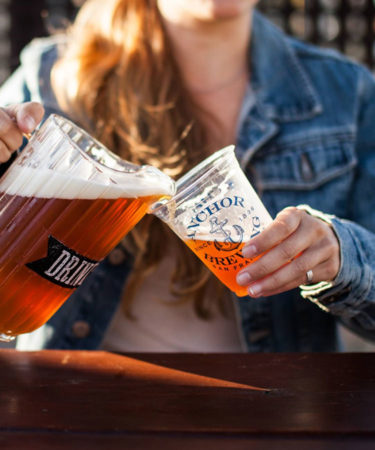Anchor Brewing may not be on your trend watch, but this American pioneer, located in San Francisco for almost 150 years, should be in your lexicon for many reasons. Here are 11 of them.
Anchor Steam Beer blew people’s minds when it first arrived
First brewed in 1896, and then revived when Frederick Louis “Fritz” Maytag III re-opened the historical brewery in 1965, Anchor Steam Beer saw its first modern bottling in 1971. The name’s origin likely originates in the brewery’s age-old practice of fermenting beer on the rooftop, due to lack of cooling equipment and ice, creating “steam” rising from the rooftops in the chilly San Francisco evening air.
Although Anchor Steam is no longer open-fermented in the elements, it is still open-fermented inside the brewery for the sake of heritage and tradition.
Anchor Brewing is regarded as America’s first craft brewery
Let’s get this out of the way: Anchor Steam is the name of a specific beer, not the brewery that makes it, which is Anchor Brewing. That said, the brand holds special significance to the brewery and beer community at large. Introduced in 1965 and first bottled in 1971, Anchor Steam is believed to be the first non-industrial beer produced, post-Prohibition, in the United States. Anchor’s success sparked the rise of independent brewing; today, we have more than 6,000 independent breweries in the U.S.
Anchor is, without question, a San Francisco treat
In 2015, the mayor of San Francisco even proclaimed the third week in August Drink Steam Week, in honor of the pioneering beverage.
Anchor started the IPA and dry-hopping trends in the 1970s
“When Fritz [Maytag] first made Liberty Ale in 1975, there was nobody dry-hopping beer anywhere in America,” Scott Ungermann, Anchor brewmaster, says. “It hadn’t been done since the initial cask-conditioned dry-hopping India Pale Ales that went to India [from Britain]. It was kind of an ancient art revived. What Fritz wanted to do was use a new hop variety he discovered, Cascade, that brought the hop to the forefront of the beer. In 1970s America, nobody else was doing that.”
Maytag devised a dry-hopping method based on “reading some old texts and digging into how IPAs were made,” Ungermann says. When it came time to brew Liberty Ale, he put hops in mesh bags and used them during secondary fermentation, aging the beer on the hops. “At the time, it was a completely new thing on the American beer scene,” Ungermann says.
In 2018, some 43 years later, Anchor is releasing its first double dry-hopped beer, Brewers Pale Ale.
Anchor made the first American version of pretty much every other ale, too
Anchor is also known for brewing the first American porter (Anchor Porter), barleywine, (Old Foghorn Ale), and Christmas Ale, the first holiday seasonal ale in the U.S., released annually since 1975.
Anchor Brewing is located in an old coffee roastery, built in 1937
After Fritz Maytag bought the brewery in 1965, he moved operations in 1977 to its Mariposa Street location, a coffee roastery that was built in 1937. This is where Anchor Brewing remains today.
Though it is anchored in San Francisco, Anchor Brewing has moved six times
A bit of history: Anchor, before it was called Anchor, was first established in 1871 by a German brewer who had emigrated to San Francisco during the 1849 Gold Rush and purchased a pub on Pacific Street that he turned into a brewery. After that, the brewery changed hands and locations six times before it landed where it is today.
This involved a series of unfortunate events — owners dying in freak accidents, a famous earthquake, multiple fires — and finally, Prohibition, which shut it down in 1920. Anchor re-opened in 1933, when Prohibition was repealed, then closed and opened and closed again, when, in 1959, American tastes turned to mass-produced light lagers. Anchor finally opened again in 1960, and was again doomed to close when its savior finally arrived.
Enter Fritz Maytag, a young college grad with a hankering for Anchor Steam Beer and “a few thousand dollars” in his pockets. Maytag purchased a 51 percent stake in the brewery in 1965, sparking the craft beer revolution. In 1977, Maytag bought a new space, where the brewery has since operated for 41 years. This is Anchor Brewing’s permanent home — for now.
Anchor opened its first public taproom in 2017
Although Anchor has been offering brewery tours since at least the 1980s, Anchor’s Public Taps, a pilot brewery and tasting room, recently opened across the street at 495 De Haro Street, in San Francisco’s Potrero neighborhood. Being a pilot brewery, a handful of beers are exclusively brewed and served on tap here, under the name “The Potrero Project.”
Anchor Brewing, forefather of American craft beer, is technically Japanese
Although Anchor has held down its historical roots in San Francisco for 147 years, Anchor was purchased by Japanese brewing giant Sapporo in August 2017. Anchor reports its beers are all still made in San Francisco.
Anchor also used to have a sister distillery
Anchor Distilling, which originally operated out of the brewery, producing such spirits as Hophead Vodka and Junipero Gin, was not part of the sale to Sapporo. The company relinquished its rights to the Anchor trademark. As of January 31, 2018, the distillery is now called Hotaling & Co., named for A.P. Hotaling, an infamous spirits dealer who made a name for himself in San Francisco during the Gold Rush. (It’s also the name of one of Anchor Distilling’s original small-batch whiskeys). In terms of ownership, the importer-distiller is no longer associated with Anchor Brewing.
Anchor named its dry-hopping method ‘Tacocat’… yes, like taco cat
As ubiquitous as the dry-hopping method has become among American craft brewers, there are as many technical methods for dry-hopping as there are definitions for double dry-hopping. Anchor uses a proprietary mechanism that it calls the “Tacocat.”
